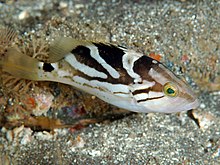Comet grouper
| Comet grouper | |
|---|---|

| |
| Scientific classification | |
| Domain: | Eukaryota |
| Kingdom: | Animalia |
| Phylum: | Chordata |
| Class: | Actinopterygii |
| Order: | Perciformes |
| Family: | Serranidae |
| Subfamily: | Epinephelinae |
| Genus: | Epinephelus |
| Species: | E. morrhua
|
| Binomial name | |
| Epinephelus morrhua Valenciennes, 1833
| |
| Synonyms[2] | |
| |
The comet grouper (Epinephelus morrhua), also known as the comet cod or dot-dash grouper, is a species of marine
Epinephelinae which is part of the family Serranidae, which also includes the anthias and sea basses. It is a species of deep coral reefs in the Indo-Pacific
region.
Description
The comet grouper has a body with a
pectoral fin. The upper part of this band runs to a dark blotch at the base of the soft rayed part of the dorsal fin. Another dark band runs from the upper margin of the gill cover to the base of spiny part of the dorsal fin. There is also a narrow band which runs from the lower margin of the orbit to the base of the pectoral fin and then continues as a broken line along the lower part of body curving upwards on to the upper part of caudal peduncle. There is another wide band from maxillary groove to rear end of interopercle. The areas between these bands are frequently marked with small brown spots. This species attains a maximum published total length of 90 centimetres (35 in), although they a more commonly found at lengths around 60 centimetres (24 in), and a maximum published weight of 6.7 kilograms (15 lb).[2]
Distribution
The comet grouper has a wide Indo-Pacific distribution and is found from the
Ogasawara Islands and as far south as New South Wales in Australia. It reaches New Caledonia, Fiji, Rotuma and the Cook Islands.[3]
Habitat and biology
The comet grouper is found near
invertebrates.[2] Its biology is poorly understood.[1] This species harbours several parasite species, including the diplectanid monogeneans Pseudorhabdosynochus morrhua and P. variabilis.[4]
Taxonomy
The comet grouper was first formally
E. radiatus, and E. tuamotoensis.[4]
Utilisation
The comet grouper is not a common fish at market, despite being regarded as an excellent food fish, probably due to the depths at which it is found.[3] Ciguatoxins have been found in fish caught off Mauritius.[4]
References
- ^ . Retrieved 19 November 2021.
- ^ a b c d e Froese, Rainer; Pauly, Daniel (eds.) (2019). "Epinephelus morhua" in FishBase. December 2019 version.
- ^ ISBN 92-5-103125-8.
- ^ a b c Bailly, Nicolas (2008). Bailly N (ed.). "Epinephelus morrhua (Valenciennes, 1833)". FishBase. World Register of Marine Species. Retrieved 12 July 2020.
- ^ Eschmeyer, William N.; Fricke, Ron & van der Laan, Richard (eds.). "Serranus morhua". Catalog of Fishes. California Academy of Sciences. Retrieved 12 July 2020.

